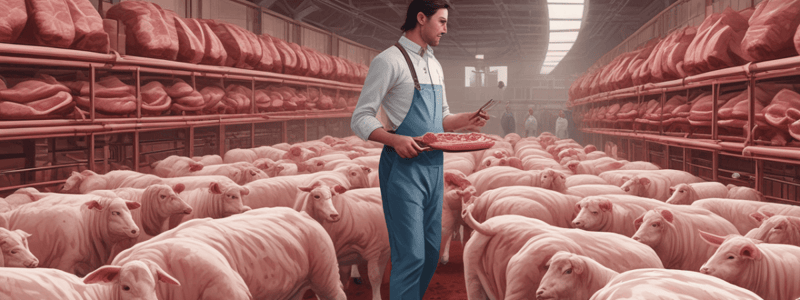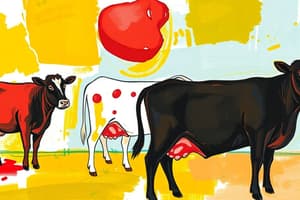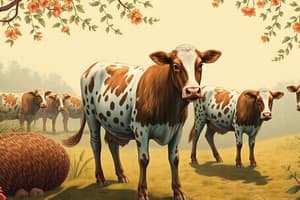Podcast
Questions and Answers
Fats are a concentrated source of energy, up to 4.25 times as much energy per unit of weight, as do carbohydrates.
Fats are a concentrated source of energy, up to 4.25 times as much energy per unit of weight, as do carbohydrates.
False (B)
Pigs are an example of ruminant animals.
Pigs are an example of ruminant animals.
False (B)
Water is not an essential nutrient for animals.
Water is not an essential nutrient for animals.
False (B)
Monogastrics are able to digest large quantities of fiber.
Monogastrics are able to digest large quantities of fiber.
Bacterial breakdown of food occurs in the large intestine of monogastrics.
Bacterial breakdown of food occurs in the large intestine of monogastrics.
What is the primary reason why carcasses from boars or stags are not used as human food?
What is the primary reason why carcasses from boars or stags are not used as human food?
What is the effect of higher percentages of yield grades on the dressing percentage?
What is the effect of higher percentages of yield grades on the dressing percentage?
Why do shipper style dressed hogs have a higher dressing percentage?
Why do shipper style dressed hogs have a higher dressing percentage?
What is the characteristic of a carcass that grades US 2?
What is the characteristic of a carcass that grades US 2?
What is the consequence of having a carcass with last rib back fat greater than 1.75 inch?
What is the consequence of having a carcass with last rib back fat greater than 1.75 inch?
What is the effect of PSE pork on the nutrient value?
What is the effect of PSE pork on the nutrient value?
What is the characteristic of PSE pork?
What is the characteristic of PSE pork?
What is the grading classification for carcasses with unacceptable quality?
What is the grading classification for carcasses with unacceptable quality?
What is the effect of having more fat on the dressing percentage?
What is the effect of having more fat on the dressing percentage?
What is the reason for not using carcasses with a strong 'sex' odor as human food?
What is the reason for not using carcasses with a strong 'sex' odor as human food?
What is the consequence of PSE pork on the nutritional value?
What is the consequence of PSE pork on the nutritional value?
What is the primary reason for the difference in dressing percentage between packer style and shipper style dressed hogs?
What is the primary reason for the difference in dressing percentage between packer style and shipper style dressed hogs?
What is the characteristic of a carcass that grades US 4?
What is the characteristic of a carcass that grades US 4?
What is the grading classification for carcasses with less than 1.0 inch of back fat and thin muscling?
What is the grading classification for carcasses with less than 1.0 inch of back fat and thin muscling?
What is the characteristic of PSE pork in terms of its water-holding capacity?
What is the characteristic of PSE pork in terms of its water-holding capacity?
What is the primary reason for not using carcasses from boars or stags as human food?
What is the primary reason for not using carcasses from boars or stags as human food?
What is the effect of higher percentages of yield grades on the dressing percentage?
What is the effect of higher percentages of yield grades on the dressing percentage?
What is the characteristic of US Utility graded carcasses?
What is the characteristic of US Utility graded carcasses?
What is the characteristic of PSE pork in terms of its texture?
What is the characteristic of PSE pork in terms of its texture?
What is the effect of having more fat on the dressing percentage?
What is the effect of having more fat on the dressing percentage?
Flashcards are hidden until you start studying
Study Notes
Meat Grading and Dressing
- Carcasses from boars or stags have a strong "sex" odor and are not passed for use as human food.
- Dressing percentage is the percentage yield of chilled carcass in relation to the weight of the live animal.
- U.S. grades for dressing percentage:
- U.S. No. 1: 70%
- U.S. No. 2: 71%
- U.S. No. 3: 72%
- U.S. No. 4: 73%
- Utility: 69%
- Poorer yield grades have higher percentages due to fatter hogs producing heavier carcasses in relation to their live weight.
- Hogs can be dressed in two ways:
- Packer style: with head, kidneys, and leaf fat removed
- Shipper style: with head, kidneys, and leaf fat left, resulting in 4-8% higher yield
Grading Exceptions
- Carcasses with thin muscling cannot grade U.S. No. 1
- A lean carcass with less than 1.0 inch of back fat, exhibiting thin muscling, will grade U.S. No. 2
- Carcasses with last rib back fat greater than 1.75 inch must grade U.S. No. 4, regardless of muscling
- Carcasses with unacceptable quality must grade U.S. Utility
PSE: Pale Soft Exudative Pork
- Characterized by a very light gray color, soft texture, inability to hold water, and separation between muscles
- Although acceptable in terms of nutritive value and taste, PSE pork may experience protein and vitamin loss
Signs of a Sick Pig
- Poor appetite
- Weakness
- Rapid, noisy breathing
- Dry, crusty, or runny nose
- Lethargic
- Limping
- Changes in skin or developed abscesses
- Diarrhea
Biosecurity
- Concerns that could introduce diseases
- Biosecurity issues:
- Herd additions
- Isolation of new animals
- People movement
- Pig movement
- Other biosecurity risks:
- Disease transmission on-farm
- Vermin control
- Vehicles
- Water and feed
Good Management for Disease Prevention
- Be alert for signs of disease and stress
- Provide clean, disinfected quarters
- Ensure adequate ventilation and sunlight
- Provide proper drainage and maintenance of holding areas
- Protect from sun, rain, and wind without overcrowding
- Practice rigid sanitation and manure removal
- Provide a well-balanced diet
- Get accurate diagnosis of health problems
- Avoid unnecessary stress and strain
- Buy disease-free stock from healthy herds
- Isolate new animals before introducing them to the herd
- Follow a set vaccination program
- Be cautious of visitors from other operations
- Dispose of dead animals immediately
Meat Quality
- Quality grades based on:
- Quality of lean meat
- Belly thickness
- Grades for carcasses with acceptable lean quality
- Carcasses with unacceptable lean or bellies that are too thin are graded U.S. Utility
Health
- Normal temperature: 101-104°F
- Normal respiratory rate: 15-30 breaths per minute
- Normal heart rate: 59-86 beats per minute
Nutrition
- Six basic nutrients: protein, carbohydrates, lipids, minerals, vitamins, and water
- Protein provides essential amino acids
- Carbohydrates are used as energy
- Fats are a concentrated source of energy
- Minerals are needed for bodily functions
- Vitamins are required for health, development, and metabolic reactions
- Water is the most important nutrient, accounting for 70% or more of the composition of most plants and animals
Digestive System
- The digestive system is a tube extending from the mouth to the anus with associated organs
- Non-ruminant (monogastric) animals have a single compartment stomach and do not regurgitate food
- Examples of monogastric animals: pigs, humans, bears, and dogs
Health
- Normal body temperature: 101-104 degrees Fahrenheit
- Normal respiratory rate: 15-30 breaths per minute
- Normal heart rate: 59-86 beats per minute
Nutrition
- Six basic nutrients: protein, carbohydrates, lipids, minerals, vitamins, and water
- Protein provides essential amino acids
- Carbohydrates provide energy for movement, growth, and reproduction
- Fats are a concentrated source of energy (2.25 times more energy per unit of weight than carbohydrates)
- Minerals are needed for body functions and are primarily found in bones and teeth
- Vitamins are required for health, development, and metabolic reactions
- Water is the most important nutrient, making up 70% or more of an animal's composition
Digestive System
- Simplest form: a tube from mouth to anus with associated organs
- Digestive systems vary depending on whether an animal is a herbivore, carnivore, or omnivore
- Non-ruminant (monogastric) animals have a single compartment stomach and do not regurgitate food
- Examples of monogastric animals: pigs, humans, bears, and dogs
- Monogastrics are unable to digest large quantities of fiber unless they have an enlarged cecum
Signs of a Sick Pig
- Poor appetite
- Weakness
- Rapid, noisy breathing
- Dry, crusty, or runny nose
- Lethargic
- Limping
- Changes in skin or developed abscesses
- Diarrhea
Biosecurity
- Items of concern that could introduce diseases:
- Herd additions
- Isolation of new animals
- People movement
- Pig movement
- Other biosecurity risks
- Disease transmission on-farm
- Vermin control
- Vehicles
- Water and feed
Good Management for Disease Prevention
- Be alert for signs of disease and stress
- Provide clean, disinfected quarters with adequate ventilation and sunlight
- Provide proper drainage and protection from the sun, rain, and wind
- Practice rigid sanitation and manure removal
- Provide a well-balanced diet
- Get accurate diagnosis of health problems
- Avoid unnecessary stress and strain
- Buy disease-free stock from healthy herds
- Isolate new animals before introducing them to the herd
- Follow a set vaccination program
- Be cautious of visitors from other operations
- Dispose of dead animals immediately
Meat
- Quality Grades are determined by:
- Quality of lean meat
- Belly thickness
- Grades for carcasses with acceptable lean quality:
- U.S. No. 1 - 70%
- U.S. No. 2 - 71%
- U.S. No. 3 - 72%
- U.S. No. 4 - 73%
- Utility - 69%
- Dressing percentage: percentage yield of chilled carcass in relation to the weight of the live animal
- Hogs can be dressed in two ways:
- Packer style (with head, kidneys, and leaf fat removed)
- Shipper style (with head, kidneys, and leaf fat left)
Grading Exceptions
- Carcasses with thin muscling cannot grade US 1
- Carcasses with last rib back fat greater than 1.75 inch must grade US 4
- Carcasses with unacceptable quality must grade US Utility
PSE: Pale Soft Exudative Pork
- Causes meat to be a very light gray color
- Muscle is very soft in texture, lacks the ability to hold water, and exhibits separation between muscles
- Although PSE pork has acceptable nutritive value and taste, some protein and vitamin loss occurs
Health
- A healthy pig's temperature ranges from 101-104 degrees Fahrenheit.
- A healthy pig's respiratory rate is between 15-30 breaths per minute.
- A healthy pig's heart rate is between 59-86 beats per minute.
Nutrition
- All feeds include six basic nutrients: protein, carbohydrates, lipids, minerals, vitamins, and water.
- Protein provides essential amino acids.
- Carbohydrates are used as energy for body functions, growth, and reproduction.
- Fats are a concentrated source of energy, providing up to 2.25 times as much energy per unit of weight as carbohydrates.
- Minerals are needed in nearly all parts of the body, primarily found in bones and teeth.
- Vitamins are required for health, development, and metabolic reactions.
- Water is the most important nutrient, accounting for 70% or more of the composition of most plants and animals.
Digestive System
- The digestive system is a tube extending from the mouth to the anus with associated organs.
- Digestive systems vary depending on whether the animals are herbivores, carnivores, or omnivores.
- Non-ruminant (monogastric) animals have a single compartment in their stomach, which swallows food after chewing and does not regurgitate.
- Examples of non-ruminant animals include pigs, humans, bears, and dogs.
Signs of a Sick Pig
- Poor appetite
- Weakness
- Rapid, noisy breathing
- Dry, crusty, or runny nose
- Lethargic behavior
- Limping
- Changes in skin or developed abscesses
- Diarrhea
Biosecurity
- Biosecurity issues include procedures to protect animals against disease or harmful biological agents.
- Items of concern that could introduce diseases include:
- Herd additions
- Isolation of new animals
- People movement
- Pig movement
- Other biosecurity risks such as disease transmission on-farm, vermin control, vehicles, water, and feed.
Good Management for Disease Prevention
- Be alert for signs of disease and conditions that can cause stress and strain.
- Provide clean, disinfected quarters, free from draft.
- Provide adequate ventilation and plenty of sunlight.
- Provide proper drainage of holding areas, barns, and free stalls.
- Protect animals from the sun, rain, and wind without overcrowding.
- Practice rigid sanitation and manure removal procedures.
- Provide a well-balanced diet.
- Get accurate diagnosis of health problems immediately.
- Avoid unnecessary stress and strain.
- Buy disease-free stock from healthy herds.
- Isolate new animals for a period before introducing them to the herd.
- Follow a set vaccination program.
- Be cautious of visitors from other operations.
- Dispose of dead animals immediately.
Meat
- Quality grades of swine carcasses consider the quality of lean meat and belly thickness.
- Grades for carcasses with acceptable lean quality are:
- U.S. No. 1
- U.S. No. 2
- U.S. No. 3
- U.S. No. 4
- Utility
- Poorer yield grades have higher percentages.
- Hogs can be dressed in two ways:
- Packer style
- Shipper style
Grading Exceptions
- Carcasses with thin muscling cannot grade U.S. 1.
- Carcasses with last rib back fat greater than 1.75 inch must grade U.S. 4.
- Carcasses with unacceptable quality must grade U.S. Utility.
PSE (Pale Soft Exudative Pork)
- PSE pork has a very light gray color.
- The muscle is very soft in texture, lacks the ability to hold water, and exhibits separation between muscles.
- Although PSE pork has acceptable nutritive value and taste, some protein and vitamin loss occurs.
Studying That Suits You
Use AI to generate personalized quizzes and flashcards to suit your learning preferences.




